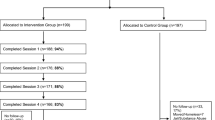Abstract
Women clients of a methadone maintenance treatment clinic were targeted for an intervention aimed to reduce unsafe sex. The hierarchical model was the basis of the single intervention session, tested among 63 volunteers. This model requires the educator to discuss and demonstrate a full range of barriers that women might use for protection, ranking these in the order of their known efficacy. The model stresses that no one should go without protection. Two objections, both untested, have been voiced against the model. One is that, because of its complexity, women will have difficulty comprehending the message. The second is that, by demonstrating alternative strategies to the male condom, the educator is offering women a way out from persisting with the male condom, so that instead they will use an easier, but less effective, method of protection. The present research aimed at testing both objections in a high-risk and disadvantaged group of women. By comparing before and after performance on a knowledge test, it was established that, at least among these women, the complex message was well understood. By comparing baseline and follow-up reports of barriers used by sexually active women before and after intervention, a reduction in reports of unsafe sexual encounters was demonstrated. The reduction could be attributed directly to adoption of the female condom. Although some women who had used male condoms previously adopted the female condom, most of those who did so had not used the male condom previously. Since neither theoretical objection to the hierarchical model is sustained in this population, fresh weight is given to emphasizing choice of barriers, especially to women who are at high risk and relatively disempowered. As experience with the female condom grows and its unfamiliarity decreases, it would seem appropriate to encourage women who do not succeed with the male condom to try to use the female condom, over which they have more control.
Similar content being viewed by others
References
New York State Department of Health, AIDS Institute.Women and HIV Prevention: Methods of Personal Protection. A Policy Statement. Albany, NY: New York State Department of Health.Focus on AIDS in New York State (newsletter); July 1992.
Cleary J, Winters S.Female condom. Efficacy, Acceptability and Relationship to the Women's Hierarchy of Risk Reduction. Albany, NY: New York State Department of Health, AIDS Institute, Division of HIV Prevention; January 1994.
Gollub EL, French P, Latka M, et al. The women's safer sex hierarchy: initial responses to counseling on women's methods of STD/HIV prevention at an STD clinic. Paper presented at: 11th International Conference on AIDS; July 17, 1996; Vancouver International AIDS Conference; Vancouver, British Columbia, Canada. Abstract MoD 583.
Elias CJ, Coggins C. Female-controlled methods to prevent sexual transmission of HIV.AIDS. 1996;10(3):S43-S51.
Soper DE, Shoupe D, Shangold GA, Shangold MM, Gutmann J, Mercer L. Prevention of vaginal trichomoniasis by compliant use of the female condom.Sex Transm Dis. 1993;20(3):137–139.
Rosenberg MJ, Davidson AJ, Chen JH, Judson FN, Douglas JM. Barrier contraceptives and sexually transmitted diseases in women: a comparison of female-dependent methods and condoms.Am J Public Health. 1992;82:669–674.
Gollub EL, French P, Latka M, Stein Z. Reducing women's risk of unwanted pregnancy and repeat STD through use of multiple barrier methods. Paper presented at: 124th American Public Health Association Conference; November 17–21, 1996; New York City.
Trussel J, Sturgen K, Stricker J, Dominik R. Comparative contraceptive efficacy of the female condom and other barrier methods.Fam Plann Perspect 1994;26:66–72.
Shervington D. The acceptability of the female condom among low income African American women.J Nat Med Assoc. 1993;85:5.
Fontanet AL, Sabha J, Chandeying V, et al. Protection against sexually transmitted diseases by granting sex workers in Thailand the choice of using the male or female condom: results from a randomized controlled trial.AIDS. 1998;12:1851–1859.
Author information
Authors and Affiliations
Corresponding author
Rights and permissions
About this article
Cite this article
Stein, Z., Saez, H., El-Sadr, W. et al. Safer sex strategies for women: The hierarchical model in methadone treatment clinics. J Urban Health 76, 62–72 (1999). https://doi.org/10.1007/BF02344462
Issue Date:
DOI: https://doi.org/10.1007/BF02344462




